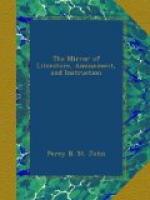At present, when the roots are taken up, the only precaution used to secure a crop the following year is to throw the smaller roots back into the holes from which they were taken, and to leave them to chance. I have no doubt that, with proper care and cultivation, any quantity might be produced. When we visited the island, we purchased the prepared arrow-root at 2d. per lb., and a missionary there informed us, that he would engage to procure any given quantity at 1-1/2d. per lb., which is, I believe, much less than it can be purchased at either in the East or the West Indies. Its quality is excellent; I should say equal to that of the East Indies, and far superior to that of Chile, with which I have since my return, had an opportunity of comparing it.
* * * * *
NOTES OF A READER.
* * * * *
JULIET’S TOMB.
“In fair Verona, where we lay our scene.”
The traditionary story of Romeo and Juliet is fact. The animosities of the houses of Montagu and the Capulet are matter of the history of Verona, where, in olden times, Pliny and Catullus were born. Juliet was buried in the soutterain of Fermo Maggiore, which belonged to an order of Franciscan friars, and was founded in 1230. Some years ago the monastery was burnt down, and the vaults and burying-place reduced to ruins. At this time the stone sarcophagus, the sepulchre of Juliet, was removed, and placed where it now is, in the entrance gateway of the monastery. The upper edge of it was entire when it was first put here, but has since been mutilated, as is represented in the Cut, for scraps to carry away as relics. Thus noted Mr. Duppa, a few years since; but we have other pilgrims and fair pens to establish the identity.
[Illustration: (Juliet’s Tomb.)]
Lord Byron, in a postscript to one of his letters from Verona, dated Nov. 7, 1816, says, “I have been over Verona. Of the truth of Juliet’s story, they seem tenacious to a degree, insisting on the fact—giving a date (1303), and showing a tomb. It is a plain, open, and partly decayed sarcophagus, with withered leaves in it, in a wild and desolate conventual garden—once a cemetery, now ruined to the very graves. The situation struck me as very appropriate to the legend, being blighted as their love. I have brought away a few pieces of the granite, to give to my daughter and my nieces."[5]




